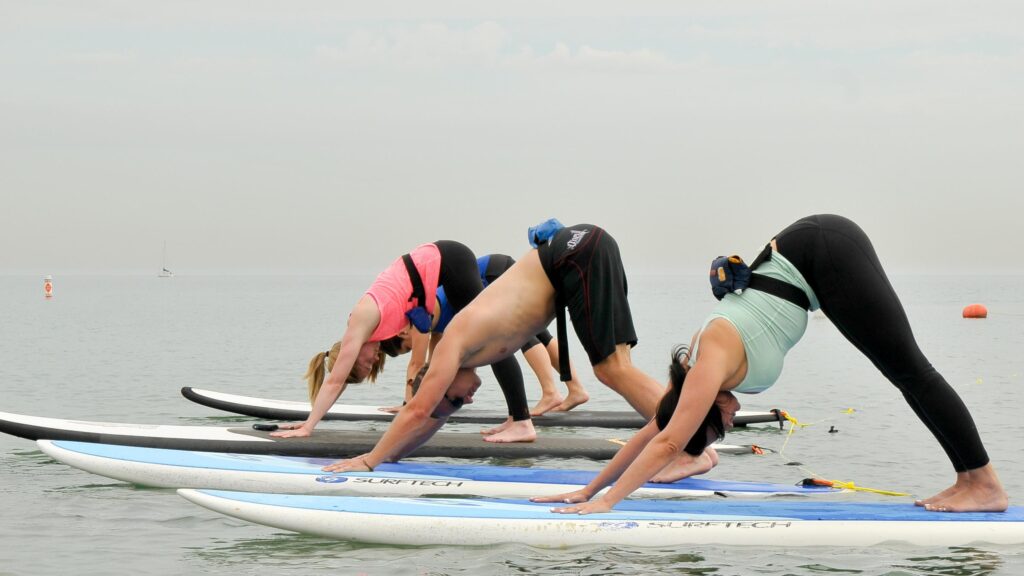If you’re looking to take your yoga practice to a whole new level, SUP yoga might be just the thing for you. Stand-Up Paddleboard (SUP) yoga combines the tranquility and mindfulness of traditional yoga with the thrill and challenge of balancing on a paddleboard in the water. SUP yoga combines the core-strengthening challenge of paddleboarding with the mindful movements of yoga, offering a unique way to connect with your breath and the natural world.
It’s an exciting and invigorating way to connect with nature while finding your balance both physically and mentally. In this blog post, we will dive into the world of SUP yoga, exploring the benefits, techniques, and tips to help you make the most of this unique and adventurous yoga practice. So grab your SUP board, find your balance, and get ready to take your yoga practice to the water!
Index of Contents
ToggleThe history of SUP yoga and how it originated

SUP yoga, or Stand-Up Paddleboard Yoga, is a unique and exhilarating way to combine the benefits of yoga with the tranquility of being on the water. But where did this innovative practice originate?
The roots of SUP yoga can be traced back to the ancient practice of yoga itself. Yoga has been around for thousands of years, originating in ancient India as a spiritual, physical, and mental discipline. It focuses on finding balance and harmony within oneself.
The concept of practicing yoga on a stand-up paddleboard, however, is a relatively recent development. It is believed that SUP yoga first emerged in the early 2000s when enterprising yogis started experimenting with taking their practice to the water.
The origin of SUP yoga can be attributed to a combination of factors. One influential figure in the development of this practice is the American yogi, R. Scott Hobbs. Hobbs, a passionate paddleboarder and yoga practitioner, began exploring the idea of merging the two disciplines in the early 2000s.
Inspired by his love for both yoga and paddleboarding, Hobbs started experimenting with performing yoga poses on a paddleboard. He quickly realized that the unstable surface of the water added an extra element of challenge and excitement to his yoga practice.
As Hobbs began sharing his experiences with others, SUP yoga gained popularity, and more yoga practitioners and fitness enthusiasts started embracing this unique form of exercise and meditation.
Since its inception, SUP yoga has evolved and gained momentum worldwide. Today, it is practiced in various bodies of water, from serene lakes to open oceans, providing participants with a refreshing and invigorating experience.
The combination of yoga and paddleboarding offers numerous benefits. The gentle rocking of the water challenges and strengthens the core muscles, improving stability and balance. The connection with nature and the soothing sounds of water create a serene and meditative environment, enhancing mindfulness and relaxation.
In conclusion, SUP yoga is a modern adaptation of the ancient practice of yoga. Its origins can be traced back to the early 2000s when yogis like R. Scott Hobbs started exploring the idea of merging yoga and stand-up paddleboarding. Today, SUP yoga continues to grow in popularity as more individuals seek to find their balance and take their yoga practice to the water.
Who are the main practitioners and influencers are in the world of SUP yoga

When it comes to the world of SUP yoga, there are several key practitioners and influencers who have made a significant impact on this unique form of yoga. One of the most well-known figures in the SUP yoga community is Dashama Konah Gordon. Dashama is an international yoga teacher and the founder of the Pranashama Yoga Institute. She has been instrumental in popularizing SUP yoga and has trained numerous instructors in this exciting practice.
Another influential figure in the world of SUP yoga is Sarah Tiefenthaler, the founder of the Yogaqua method. Sarah has combined her love for yoga and stand-up paddleboarding to create a seamless and enjoyable experience for practitioners. Her method focuses on the integration of yoga poses and paddleboarding techniques, allowing individuals to find balance and serenity on the water.
Additionally, we cannot forget the contributions of Rachel Brathen, known as Yoga Girl, whose vibrant presence on social media has helped to showcase the beauty and benefits of SUP yoga to a wider audience. Her passion for yoga, combined with her love for nature, has made her a prominent influencer in the world of SUP yoga.
These practitioners and influencers have played a crucial role in inspiring and educating individuals about SUP yoga. Through their teachings, workshops, and online platforms, they have helped to cultivate a community of SUP yogis who are eager to take their yoga practice to the water and find their balance in a new and invigorating way. Whether you are a beginner or an experienced yogi, exploring the guidance and insights of these practitioners can truly enhance your SUP yoga journey.
The benefits of SUP yoga on physical and mental health.
SUP yoga, also known as stand-up paddleboard yoga, is an incredible fusion of two popular activities – yoga and paddleboarding. This unique form of yoga takes your practice to the water, providing a serene and tranquil environment that enhances the mind-body connection. Beyond the picturesque backdrop and serene setting, SUP yoga offers numerous benefits to both physical and mental health.
First and foremost, the balance required to perform yoga on a paddleboard adds an additional element of challenge and engagement to your practice. The unstable surface of the water requires you to engage your core muscles constantly, improving your balance, stability, and overall strength. As you flow through various poses on the board, you’ll notice a significant improvement in your core strength and stability, which can have positive effects on your posture and overall body alignment.
The therapeutic nature of being on the water also adds to the mental benefits of SUP yoga. The sound of water gently lapping against the board, the gentle rocking motion, and the fresh air all contribute to a sense of calm and relaxation. This unique environment helps to reduce stress levels and promotes a deep sense of tranquility, allowing you to connect with nature and find inner peace.
Another significant advantage of SUP yoga is the added challenge it brings to your mindfulness practice. With each pose, you must be fully present, focused, and aware of your body’s movements to maintain your balance on the board. This heightened mindfulness allows you to deepen your practice, cultivating a stronger mind-body connection and enhancing your overall yoga experience.
Furthermore, the combination of being out in nature, engaging in physical activity, and practicing yoga has been proven to boost endorphin levels, leading to an increased sense of happiness and well-being. SUP yoga provides an opportunity to escape the hustle and bustle of daily life and connect with the elements, revitalizing your spirit and rejuvenating your mind.
In conclusion, SUP yoga offers a refreshing and invigorating way to practice yoga while reaping numerous physical and mental health benefits. From improving balance and strength to reducing stress and enhancing mindfulness, this water-based practice allows you to find your balance both on and off the paddleboard. So, grab your board, embrace the serenity of the water, and take your yoga practice to new depths with SUP yoga.
Necessary equipment and safety precautions for practicing SUP yoga.
When it comes to practicing SUP Yoga, it’s important to have the right equipment and take necessary safety precautions to ensure a safe and enjoyable experience on the water.
First and foremost, you will need a paddleboard specifically designed for yoga, also known as a SUP yoga board. These boards are wider and more stable than traditional paddleboards, providing a sturdy platform for your yoga practice. Look for a board that is at least 10 to 12 feet long and 32 inches wide to ensure stability and balance.
In addition to a SUP yoga board, you will need a paddle that is the appropriate length for your height. Choose a paddle that is lightweight and adjustable so you can customize it to your preferred length. This will help you maintain proper form and prevent strain on your upper body while paddling to your yoga spot.
Safety is paramount when practicing SUP yoga. Always wear a personal flotation device (PFD) or life jacket, especially if you are not a strong swimmer. It’s also a good idea to wear a leash that attaches you to your paddleboard, helping to prevent separation in case of a fall. Remember, a calm body of water with minimal boat traffic is ideal for SUP yoga.
Before heading out onto the water, it’s essential to check the weather forecast and water conditions. Avoid practicing in strong winds, rough waters, or areas with strong currents. It’s also a good practice to inform someone of your plans and estimated time of return, especially if you’re practicing alone.
Lastly, don’t forget to apply sunscreen to protect your skin from harmful UV rays, as you will be exposed to direct sunlight while practicing SUP yoga. Consider wearing a hat and sunglasses for added sun protection.
By having the necessary equipment and following safety precautions, you can fully enjoy the unique experience of practicing yoga on a stand-up paddleboard. Find your balance, connect with nature, and take your yoga practice to the water with SUP yoga!
Impact of SUP yoga on the environment and how it can be practiced in a sustainable way.
SUP Yoga, also known as Stand-Up Paddleboard Yoga, is a unique and exhilarating way to take your yoga practice to the water. While enjoying the serenity of nature and the gentle rocking of the water, SUP yoga provides an additional challenge to balance and stability, enhancing both physical and mental strength.
However, as with any outdoor activity, it is crucial to be mindful of the impact it has on the environment. SUP yoga can be practiced in a sustainable way by following a few key principles. Firstly, it is essential to choose eco-friendly gear, such as using a paddleboard made from recycled materials or sustainably sourced wood. Additionally, opting for a paddle made from renewable resources like bamboo can further reduce the environmental footprint.
When practicing SUP yoga, it is important to respect the natural habitat and wildlife. Avoid disturbing aquatic plants and animals, and be mindful of nesting areas or protected marine zones. It is also crucial to properly dispose of any waste or litter, ensuring that nothing is left behind to harm the environment or wildlife.
In terms of transportation, consider carpooling or using eco-friendly modes of transportation to reach your SUP yoga location. Minimizing carbon emissions by reducing travel distance or opting for non-motorized waterways can have a positive impact on the environment.
Lastly, supporting local businesses that prioritize sustainability can contribute to the overall eco-consciousness of SUP yoga. Look for eco-friendly SUP yoga instructors or organizations that actively participate in beach and waterway cleanups or conservation initiatives.
By practicing SUP yoga with a sustainable mindset, we can fully appreciate the beauty of the natural world while minimizing our impact on it. Let’s find our balance on the water and strive to leave only ripples of positivity and reverence for the environment.
Compare and contrast SUP yoga with traditional yoga and paddleboarding.
When it comes to finding balance and taking your yoga practice to a whole new level, SUP yoga is a unique and exhilarating experience that combines the principles of traditional yoga with the added challenge of practicing on a paddleboard.
Unlike traditional yoga, which is typically done on a mat indoors, SUP yoga takes place on a stand-up paddleboard in the open water. This dynamic environment adds an extra element of challenge and excitement to your practice, as you have to constantly engage your core and make adjustments to maintain stability on the water. The gentle rocking of the board also adds an element of mindfulness and focus, requiring you to be fully present in the moment.
In terms of paddleboarding, SUP yoga takes the basic principles of paddleboarding and incorporates yoga poses and flows. While paddleboarding is primarily a recreational activity that focuses on balance, core strength, and navigating the water, SUP yoga takes it a step further by incorporating traditional yoga poses and sequences. This fusion of disciplines creates a unique and engaging workout that not only strengthens your body but also calms your mind.
One key difference between SUP yoga and traditional yoga is the increased emphasis on core strength and stability. As you practice yoga poses on an unstable surface like a paddleboard, your core muscles are constantly engaged in order to maintain balance. This not only enhances the physical benefits of your yoga practice but also helps to improve overall stability and coordination.
Another difference is the connection with nature that SUP yoga offers. Practicing yoga on the water allows you to fully immerse yourself in the natural surroundings, feeling the sun on your skin, hearing the gentle lapping of the water, and experiencing the freedom of being in the great outdoors. This connection to nature can deepen your sense of peace and tranquility during your practice.
While traditional yoga and paddleboarding each have their own unique benefits, SUP yoga combines the best of both worlds. It offers a fun and challenging way to strengthen your body, improve your balance, and deepen your yoga practice. Whether you’re a seasoned yogi or a beginner looking for a new way to connect with your practice, SUP yoga is an experience worth trying. So grab your paddleboard, find your balance, and let the water guide you on a journey of self-discovery and inner peace.
The potential for SUP yoga to become a mainstream form of exercise and relaxation.
SUP yoga, also known as stand-up paddleboard yoga, is a unique and exhilarating way of practicing yoga that combines the benefits of both paddleboarding and yoga. While still relatively new, SUP yoga has gained popularity and has the potential to become a mainstream form of exercise and relaxation.
One of the reasons for its growing popularity is the incredible experience it offers. Imagine practicing your yoga poses on a paddleboard, surrounded by the serenity of water and nature. The challenge of maintaining balance on an unstable surface adds a whole new level of intensity to your practice, requiring greater focus, strength, and stability.
In addition to the physical benefits, SUP yoga also offers a mental and spiritual connection to nature. Being on the water can have a calming and grounding effect, allowing you to deeply connect with your surroundings. The gentle rocking of the board and the sound of water can further enhance your mind-body connection, helping you find a sense of peace and tranquility.
Furthermore, SUP yoga is accessible to people of all fitness levels and ages. Even if you have never tried paddleboarding before or are new to yoga, SUP yoga provides a safe and supportive environment to explore and challenge yourself. With proper guidance and instruction, beginners can easily adapt to the unique dynamics of practicing yoga on a paddleboard.
As more people discover the benefits of SUP yoga and experience the joy of practicing yoga on the water, it is likely to become a mainstream form of exercise and relaxation. Its ability to combine physical fitness, mental clarity, and a deep connection to nature makes it an appealing choice for those seeking a holistic approach to their well-being. So, if you’re looking to take your yoga practice to new heights, or rather, to the water, SUP yoga is definitely worth a try.
Controversies or criticisms surrounding SUP yoga and how to address them in the essay
While SUP yoga has gained popularity in recent years, it is not without its controversies and criticisms. Some argue that practicing yoga on a paddleboard is a risky endeavor and may lead to injuries. Others claim that it dilutes the spiritual aspect of traditional yoga by turning it into a trendy water sport. It is important to address these concerns and offer a balanced perspective in any essay or discussion about SUP yoga.
To address the potential risks and injuries associated with SUP yoga, it is crucial to emphasize the importance of proper training and supervision. Beginners should receive adequate instruction on paddleboarding techniques and safety measures before attempting SUP yoga. Additionally, certified instructors should be present during classes to guide participants and ensure their well-being.
Regarding the criticism of SUP yoga as a commercialized version of traditional yoga, it is essential to highlight that it is simply a different way to experience and explore the practice. While the physical and mental benefits of yoga remain integral to SUP yoga, the environment in which it is practiced adds an extra element of balance, core strength, and connection to nature. Instead of viewing it as a dilution of yoga, SUP yoga can be seen as an innovative and enjoyable variation that appeals to those seeking a unique experience.
Moreover, it is crucial to acknowledge that SUP yoga may not be accessible or suitable for everyone. Factors such as location, weather conditions, and personal physical abilities can limit participation. It is important to encourage individuals to assess their own capabilities and consult with healthcare professionals before attempting SUP yoga.
By addressing these controversies and criticisms in a fair and balanced manner, we can provide readers with a comprehensive understanding of SUP yoga. Ultimately, it is up to individuals to decide whether they are interested in exploring this practice and to do so with caution and mindfulness.
Conclusion
SUP yoga is a unique form of yoga that allows you to enhance your yoga practice while connecting with nature in a whole new way. By combining the serenity of yoga with the excitement of balancing on a paddleboard, you can challenge yourself physically and mentally while enjoying the beauty of the water.
If you are new to SUP yoga, you might be wondering how it works. In SUP yoga, you practice yoga on a paddleboard while floating on the water. This requires you to engage your core muscles more deeply than you would in a traditional yoga practice, as you are constantly working to maintain balance on an unstable surface.
One of the most significant benefits of SUP yoga is that it can help improve your balance. When you practice yoga on a paddleboard, you are constantly adjusting your body to maintain balance, which helps to strengthen your core muscles and improve your overall balance and stability.
Another benefit of SUP yoga is that it can help you cultivate a deeper connection with your breath. As you move through your practice on the water, you become more aware of your breath and how it supports your movements. This can help you cultivate a sense of calm and focus that you can take with you off the paddleboard and into your daily life.
Whether you are an experienced yogi or new to the practice, SUP yoga offers a refreshing and invigorating experience that can help you deepen your connection with yourself and with nature. So grab your SUP board, embrace the adventure, and take your yoga practice to the water!



